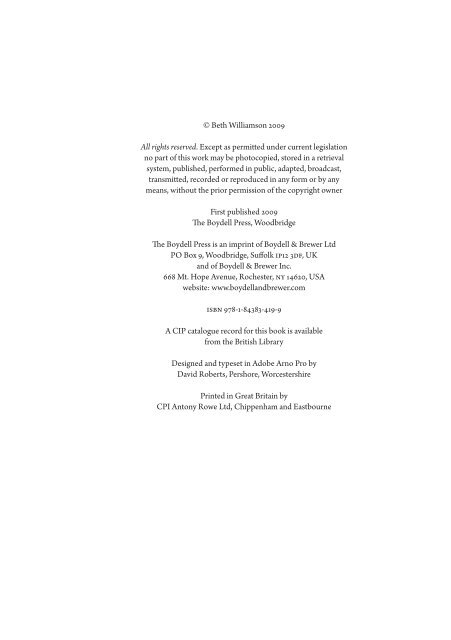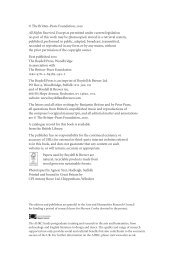The Madonna of Humility - Boydell & Brewer
The Madonna of Humility - Boydell & Brewer
The Madonna of Humility - Boydell & Brewer
Create successful ePaper yourself
Turn your PDF publications into a flip-book with our unique Google optimized e-Paper software.
© Beth Williamson 2009<br />
All rights reserved. Except as permitted under current legislation<br />
no part <strong>of</strong> this work may be photocopied, stored in a retrieval<br />
system, published, performed in public, adapted, broadcast,<br />
transmitted, recorded or reproduced in any form or by any<br />
means, without the prior permission <strong>of</strong> the copyright owner<br />
First published 2009<br />
<strong>The</strong> <strong>Boydell</strong> Press, Woodbridge<br />
<strong>The</strong> <strong>Boydell</strong> Press is an imprint <strong>of</strong> <strong>Boydell</strong> & <strong>Brewer</strong> Ltd<br />
PO Box 9, Woodbridge, Suffolk ip12 3df, UK<br />
and <strong>of</strong> <strong>Boydell</strong> & <strong>Brewer</strong> Inc.<br />
668 Mt. Hope Avenue, Rochester, ny 14620, USA<br />
website: www.boydellandbrewer.com<br />
isbn 978-1-84383-419-9<br />
A CIP catalogue record for this book is available<br />
from the British Library<br />
Designed and typeset in Adobe Arno Pro by<br />
David Roberts, Pershore, Worcestershire<br />
Printed in Great Britain by<br />
CPI Antony Rowe Ltd, Chippenham and Eastbourne
Contents<br />
List <strong>of</strong> Illustrations<br />
Acknowledgements<br />
vi<br />
x<br />
Introduction 1<br />
part i Development<br />
1 <strong>The</strong> <strong>Madonna</strong> <strong>of</strong> <strong>Humility</strong>:<br />
Descriptions and Definitions 15<br />
2 <strong>The</strong> <strong>Madonna</strong> <strong>of</strong> <strong>Humility</strong> in Avignon 29<br />
3 Early Appearances <strong>of</strong> the Image 70<br />
part ii Dissemination<br />
4 Bohemia 86<br />
5 Siena and Florence 112<br />
part iii Reception<br />
6 Image and Ideal 132<br />
7 Using the <strong>Madonna</strong> <strong>of</strong> <strong>Humility</strong> 148<br />
8 Responding to the <strong>Madonna</strong> <strong>of</strong> <strong>Humility</strong> 166<br />
Conclusion 175<br />
Bibliography 179<br />
Index 189
chapter 1<br />
<strong>The</strong> <strong>Madonna</strong> <strong>of</strong> <strong>Humility</strong>:<br />
Descriptions and Definitions<br />
<strong>The</strong> name ‘<strong>Madonna</strong> <strong>of</strong> <strong>Humility</strong>’ has been used as the designation<br />
<strong>of</strong> a group <strong>of</strong> images chiefly because some examples carry inscriptions<br />
designating the Virgin as ‘Our Lady <strong>of</strong> <strong>Humility</strong>’. <strong>The</strong> earliest dated example<br />
(1346), by Bartolomeo da Camogli, in the Palazzo Abatellis in Palermo<br />
(Colour plate i) is inscribed ‘n[ost]ra d[on]na de humilitate’, and<br />
that by Fra Paolo da Modena in the Galleria Estense in Modena (illus. 1) is<br />
inscribed ‘la nostra donna d[e] umilita’. However, there are other<br />
examples <strong>of</strong> the same iconography which are inscribed differently from the<br />
Palermo and Modena paintings. <strong>The</strong>refore we must consider whether, in<br />
fact, an inscription such as ‘Nostra Donna de Humilitate’ can be regarded<br />
as describing and circumscribing a distinct and recognisable iconographical<br />
type, when other examples <strong>of</strong> the same iconography exhibit different<br />
inscriptions. This study will examine this group <strong>of</strong> images that are brought<br />
together as a ‘type’ under the banner <strong>of</strong> inscriptions referring to humility. It<br />
will suggest that, since many examples <strong>of</strong> the Virgin seated on the ground<br />
do not in fact carry inscriptions relating to humility, and many carry inscriptions<br />
with a completely different focus, it is probably not wise to think <strong>of</strong><br />
‘the <strong>Madonna</strong> <strong>of</strong> <strong>Humility</strong>’ as a ‘title’ that describes the iconography <strong>of</strong> a category<br />
<strong>of</strong> image, but rather as a reference to a mental or spiritual characteristic<br />
<strong>of</strong> the Virgin Mary. Later chapters will explore the range <strong>of</strong> meanings that<br />
this image might have had in the various areas <strong>of</strong> its early diffusion, and will<br />
challenge the long-held assumption that this group <strong>of</strong> images represents a<br />
unified and homogenous type with one over-arching meaning.<br />
Linked with the assumption that these images represent a coherent ‘type’<br />
has been the conviction that the image <strong>of</strong> the Virgin seated on the ground<br />
was invented to express the Virgin’s humility. <strong>The</strong> etymological connection<br />
<strong>of</strong> ‘humus’ (ground) and ‘humilitas’ (humility) has been <strong>of</strong>fered as support<br />
for this suggestion. 1 However, a consideration <strong>of</strong> the processes by which this<br />
group <strong>of</strong> images came to be developed will <strong>of</strong>fer an alternative suggestion<br />
for the origins and meaning <strong>of</strong> the seated posture in these images. This will<br />
further indicate that ‘Nostra Donna de Humilitate’ or ‘La Nostra Donna de<br />
Umilita’ should not be thought <strong>of</strong> as ‘titles’ describing the iconography <strong>of</strong><br />
what we call ‘the <strong>Madonna</strong> <strong>of</strong> <strong>Humility</strong>’, but that they bear a more complicated<br />
relationship to the meaning <strong>of</strong> the images, related to the qualities and<br />
attributes <strong>of</strong> the Virgin.<br />
1 See below, 18–19.
16<br />
<strong>The</strong> <strong>Madonna</strong> <strong>of</strong> <strong>Humility</strong><br />
<strong>The</strong>re have been several studies <strong>of</strong> the image, most <strong>of</strong> which have been<br />
concerned with the place <strong>of</strong> origin, and with the way in which the image<br />
might have been developed. As far back as 1935 Georgiana Goddard King<br />
argued for a Spanish origin, developing out <strong>of</strong> images <strong>of</strong> the Woman <strong>of</strong> the<br />
Apocalypse in Spanish Apocalypse manuscripts. 2 Millard Meiss, a year later,<br />
argued for a Central Italian origin, developing out <strong>of</strong> images <strong>of</strong> the Virgin<br />
seated on the ground at the Nativity. 3 In 1969, Henk van Os published a<br />
book on ‘Humble <strong>Madonna</strong>s’, 4 in which he developed further the discussion<br />
<strong>of</strong> the <strong>Madonna</strong> <strong>of</strong> <strong>Humility</strong>. He agreed with Meiss that the image had a<br />
Central Italian origin, but he suggested that the type had developed out <strong>of</strong> the<br />
seated Virgin Annunciate. More recently, Joseph Polzer has broadened the<br />
base <strong>of</strong> suggested source images by investigating Central Italian representations<br />
<strong>of</strong> the Crucifixion in which the Virgin sinks to the ground beside the<br />
crucifix. 5<br />
Millard Meiss’s 1936 article has remained influential, and is still the most<br />
frequently cited source on the type in general works and catalogues. He suggested<br />
that the <strong>Madonna</strong> <strong>of</strong> <strong>Humility</strong> composition was invented by Simone<br />
Martini, whose earliest dated work was in Siena, and who produced much<br />
important work for that city, but who also produced work for patrons all over<br />
Central Italy, including in Assisi, Orvieto and San Gimignano, as well as for<br />
patrons in Naples and Avignon. Meiss’s guiding method was to consider the<br />
<strong>Madonna</strong> <strong>of</strong> <strong>Humility</strong> as a devotional image derived from a narrative image.<br />
Erwin Pan<strong>of</strong>sky produced the classic definition <strong>of</strong> this process <strong>of</strong> derivation<br />
in his discussion <strong>of</strong> the type <strong>of</strong> image he called the Andachtsbild, an image<br />
designed to be the focus <strong>of</strong> devotion, excerpted from a narrative context<br />
which focuses on moments <strong>of</strong> high emotion or pathos with the intention<br />
<strong>of</strong> arousing the viewer’s compassion. 6 Meiss saw the process <strong>of</strong> the development<br />
<strong>of</strong> the <strong>Madonna</strong> <strong>of</strong> <strong>Humility</strong> as ‘an isolation <strong>of</strong> a group appearing<br />
2 Georgiana Goddard King, ‘<strong>The</strong> Virgin <strong>of</strong> <strong>Humility</strong>’, Art Bulletin, 17 (1935), 474–91.<br />
3 Millard Meiss, ‘<strong>The</strong> <strong>Madonna</strong> <strong>of</strong> <strong>Humility</strong>’, Art Bulletin, 18 (1936), 435–64; reprinted in<br />
Meiss’s Painting in Florence and Siena after the Black Death (Princeton, 1951), 132–56. Unless<br />
otherwise indicated, all references here will be to this reprinted version.<br />
4 Henk Van Os, Marias Demut und Verherrlichung in der sienesischen Malerei, 1300–1450 (<strong>The</strong><br />
Hague, 1969) [originally published in Dutch, as the author’s doctoral thesis].<br />
5 Joseph Polzer, ‘Concerning the origin <strong>of</strong> the <strong>Madonna</strong> <strong>of</strong> <strong>Humility</strong>’, RACAR: Revue d’art<br />
Canadienne/Canadian Art Review, 27:1–2 (2000), 1–31.<br />
6 Erwin Pan<strong>of</strong>sky, ‘ “Imago Pietatis”: ein Beitrag zur Typengeschichte des “Schmerzensmanns”<br />
und der “Maria Mediatrix” ’, in Festschrift für Max J. Friedländer zum 60. Geburtstag<br />
(Leipzig, 1927), 261–308. Other more recent studies <strong>of</strong> this process <strong>of</strong> image development<br />
include: Sixten Ringbom, Icon to Narrative: <strong>The</strong> Rise <strong>of</strong> the Dramatic Close-up in Fifteenth-<br />
Century Devotional Painting, 2nd ed. (Doornspijk, 1984); Hans Belting, <strong>The</strong> Image and Its<br />
Public in the Middle Ages: Form and Function <strong>of</strong> Early Paintings <strong>of</strong> the Passion, trans. Mark<br />
Bartusis and Raymond Meyer (New Rochelle, NY, 1990), translation <strong>of</strong> the German<br />
original, Das Bild und sein Publikum im Mittelalter: Form und Funktion früher Bildtafeln<br />
der Passion (Berlin, 1981); Karl Schade, Andachtsbild: die Geschichte eines kunsthistorischen<br />
Begriffs (Weimar, 1996).
Descriptions and Definitions 17<br />
in an historical scene, which was, in this instance, the Nativity.’ 7 He noted<br />
that the evolution <strong>of</strong> the Nativity in the first third <strong>of</strong> the fourteenth century<br />
in Tuscany was ‘characterized by an increasingly affectionate and intimate<br />
relationship between the Virgin and Child.’ 8 He traced a development from<br />
Giotto’s fresco in the Arena Chapel, where the Virgin reaches towards her<br />
child, 9 through other Nativity paintings by Giotto and his circle, where the<br />
Virgin holds the child in front <strong>of</strong> her, to paintings by Bernardo Daddi and<br />
Taddeo Gaddi, where she holds the nursing infant at her breast. 10 This latter<br />
group <strong>of</strong> paintings, Meiss argued, served as the source for the <strong>Madonna</strong><br />
<strong>of</strong> <strong>Humility</strong>. He envisaged a process where the composition <strong>of</strong> the Virgin<br />
seated on the ground, suckling her child, was abstracted from the Nativity<br />
narrative, and became the basis for the new devotional image. This understanding<br />
<strong>of</strong> the process <strong>of</strong> development was supported by all the other writers<br />
who investigated the origins <strong>of</strong> the image, even where they saw a different<br />
narrative as providing the original source, such as the Annunciation or<br />
the Crucifixion.<br />
In fact, none <strong>of</strong> these narrative images, neither the Nativity, nor the<br />
Annunciation, nor the Crucifixion, provides a basis for all the iconographical<br />
elements <strong>of</strong> the <strong>Madonna</strong> <strong>of</strong> <strong>Humility</strong> image as it developed in the 1340s<br />
and beyond. <strong>The</strong> Nativity image might explain the seated posture and<br />
the suckling motif, but it does not explain the frequent references to the<br />
Annunciation (unless we were to see the Annunciation as a generally alldefining<br />
event in the Virgin’s life as Mother <strong>of</strong> Christ, and therefore understandable<br />
as a background or an addition to any image <strong>of</strong> the Virgin Mary).<br />
<strong>The</strong> alternative suggestion that the <strong>Madonna</strong> <strong>of</strong> <strong>Humility</strong> was abstracted<br />
out <strong>of</strong> the Annunciation better explains the presence <strong>of</strong> the lily or the book,<br />
and references to the Angel, but does not immediately explain the addition<br />
<strong>of</strong> the suckling motif. <strong>The</strong> Crucifixion explains neither the suckling motif<br />
nor the Annunciation references. And none <strong>of</strong> these three images provides<br />
a reason for the addition <strong>of</strong> the Apocalyptic symbols <strong>of</strong> the sun, moon and<br />
stars. Georgiana Goddard King’s hypothesis that the <strong>Madonna</strong> <strong>of</strong> <strong>Humility</strong><br />
was derived from illustrations <strong>of</strong> the Woman <strong>of</strong> the Apocalypse in Spanish<br />
Apocalypse manuscripts <strong>of</strong> the twelfth and thirteenth century (specifically<br />
those illustrating the eighth-century commentary <strong>of</strong> the Spanish monk<br />
Beatus, and thus known as ‘Beatus Apocalypses’ ) 11 provides the best connection<br />
with these Apocalypse symbols. But her theory was rejected by<br />
Meiss, who suggested that the relationship which King traced between<br />
the illustrated Beatus manuscripts and the <strong>Madonna</strong> <strong>of</strong> <strong>Humility</strong> seemed<br />
7 Meiss, ‘<strong>Madonna</strong> <strong>of</strong> <strong>Humility</strong>’, 147.<br />
8 Meiss, ‘<strong>Madonna</strong> <strong>of</strong> <strong>Humility</strong>’, 147.<br />
9 See James H. Stubblebine, Giotto: <strong>The</strong> Arena Chapel Frescoes (London, 1969), fig. 25.<br />
10 For example, the panel by Taddeo Gaddi in Berlin: Meiss, ‘<strong>Madonna</strong> <strong>of</strong> <strong>Humility</strong>’, fig. 159.<br />
11 See John Williams, <strong>The</strong> Illustrated Beatus: A Corpus <strong>of</strong> the Illustrations <strong>of</strong> the Commentary on<br />
the Apocalypse, 5 vols. (London, 1994–2003).
18<br />
<strong>The</strong> <strong>Madonna</strong> <strong>of</strong> <strong>Humility</strong><br />
improbable, on the basis that the Beatus manuscripts tend to show the<br />
Woman standing in the heavens. 12 In other words, King’s theory provided<br />
an explanation for the Apocalypse symbols, but not for the Annunciation<br />
references, nor for the suckling motif, and not even for the seated<br />
posture.<br />
Meiss denied that there was any connection between the <strong>Madonna</strong> <strong>of</strong><br />
<strong>Humility</strong> and the Woman <strong>of</strong> the Apocalypse, and suggested that these symbols<br />
were added to an image <strong>of</strong> the Virgin seated on the ground to indicate<br />
her queenly sublimity: according to, as he put it, ‘a principle <strong>of</strong> polarity in<br />
Christian thought’ which determined ‘the almost paradoxical combination<br />
<strong>of</strong> the humble image <strong>of</strong> the mother nursing her Child with the awesome<br />
Woman described in the twelfth chapter <strong>of</strong> the Apocalypse’. 13 By such a combination<br />
the image could represent not just humility, by the seated position,<br />
close to the ground, but also sublimity, by showing the Virgin as Queen <strong>of</strong><br />
Heaven, with the sun and the moon, and the crown <strong>of</strong> twelve stars.<br />
Despite this address to the meaning <strong>of</strong> the Apocalypse symbols, however,<br />
Meiss remained unsure about their relationship to the <strong>Madonna</strong> <strong>of</strong><br />
<strong>Humility</strong> image. But there was no uncertainty about the seated posture.<br />
For Meiss the seated posture was the principal indicator <strong>of</strong> the Virgin’s<br />
humility in this image. 14 This was because inscriptions referring to the<br />
concept <strong>of</strong> humility can be found not only on images which show the combination<br />
<strong>of</strong> the seated posture, the suckling motif and the sun moon and<br />
stars, such as Bartolomeo da Camogli’s early example (Colour plate i) but<br />
also on images that show only the seated posture, such as that by Don<br />
Silvestro dei Gherarducchi in the Accademia in Florence (Colour plate<br />
ii). This particular example is inscribed respexit · humilitatem ·<br />
ancille · sue · ecce · e[nim] · e x · h o c · b[ea]ta[m] · m e . This is a<br />
quotation from the third and fourth lines <strong>of</strong> the Magnificat, the hymn uttered<br />
by the Virgin in response to the Annunciation, 15 and is therefore rather a different<br />
evocation <strong>of</strong> humility from the inscriptions which address the Virgin<br />
as ‘Our Lady <strong>of</strong> <strong>Humility</strong>’. However, the mention <strong>of</strong> humility, and the lack<br />
<strong>of</strong> the suckling posture or the Apocalypse symbols in this particular image,<br />
was enough to confirm for Meiss that ‘the humility <strong>of</strong> the Virgin resided<br />
primarily in the single fact that she was seated on the ground’. 16<br />
This conviction was further confirmed for Meiss by the etymological<br />
connection <strong>of</strong> the word humilitas with the Latin word for ground: humus.<br />
Isidore <strong>of</strong> Seville (d. 636) had observed that the root <strong>of</strong> humilitas was humus<br />
12 Meiss, ‘<strong>Madonna</strong> <strong>of</strong> <strong>Humility</strong>’, 155 n. 105.<br />
13 Meiss, ‘<strong>Madonna</strong> <strong>of</strong> <strong>Humility</strong>’, 153.<br />
14 Meiss, ‘<strong>Madonna</strong> <strong>of</strong> <strong>Humility</strong>’, 132 n. 1.<br />
15 ‘Quia respexit humilitatem ancillæ suæ: ecce enim ex hoc beatam me dicent omnes<br />
generationes’ (Luke 1:48): ‘For he has regarded the lowliness <strong>of</strong> his handmaiden: for<br />
behold from henceforth all generations shall call me blessed’.<br />
16 Meiss, ‘<strong>Madonna</strong> <strong>of</strong> <strong>Humility</strong>’, 132 n. 1.
Descriptions and Definitions 19<br />
(‘humilitas dicitur quasi humo acclini’ ) 17 and Thomas Aquinas had quoted<br />
this etymology in his Summa theologiae. 18 As Meiss put it ‘it remained for<br />
the Italian painters <strong>of</strong> this period [i.e. the fourteenth century] to enact the<br />
virtue in the <strong>Madonna</strong> <strong>of</strong> <strong>Humility</strong>’. 19 His contention was that an image <strong>of</strong><br />
the Virgin seated on the ground was invented to express the Virgin’s humility,<br />
and thus to illustrate Isidore’s etymology. Meiss regarded other elements<br />
– the Apocalypse symbols, the Annunciation motifs – as additions to that<br />
basic correspondence between the seated posture and the idea <strong>of</strong> humility.<br />
All subsequent commentators have thus focused on the seated posture<br />
as the defining characteristic <strong>of</strong> the type and therefore have sought models<br />
that seem adequately to explain that particular characteristic.<br />
<strong>The</strong> perception that the <strong>Madonna</strong> <strong>of</strong> <strong>Humility</strong> image graphically illustrated<br />
the virtue <strong>of</strong> humility was bolstered by an understanding that another<br />
<strong>of</strong> the key elements present in the majority <strong>of</strong> examples <strong>of</strong> the theme (the<br />
motif <strong>of</strong> breast-feeding) was also linked with the virtue <strong>of</strong> humility. In<br />
this case the association was a little more convoluted than humus: humilitas.<br />
Meiss suggested that the image <strong>of</strong> the suckling Virgin signified moral<br />
qualities such as benevolence and mercy and that, for this reason, it was suitable<br />
to be represented within the context <strong>of</strong> the <strong>Madonna</strong> <strong>of</strong> <strong>Humility</strong>. <strong>The</strong><br />
image <strong>of</strong> the breast-feeding Virgin, or Virgin Lactans, is a much wider type<br />
than the <strong>Madonna</strong> <strong>of</strong> <strong>Humility</strong>, and the Virgin breast-feeding appears in<br />
enthroned, standing and half-length compositions, and in settings very far<br />
removed from any obvious connotation <strong>of</strong> humility. 20 However, an assumption<br />
has tended to be made in the literature that the image <strong>of</strong> the suckling<br />
Virgin is generally to be regarded as connected with humility. Part <strong>of</strong> the<br />
reason for this is that Meiss, and others, such as Marina Warner, 21 for example,<br />
have discussed the image against the background <strong>of</strong> a belief that in the<br />
later Middle Ages the act <strong>of</strong> maternal feeding was commonly regarded as<br />
indicative <strong>of</strong> low status, and thus humbling or even humiliating.<br />
Meiss argued that the image <strong>of</strong> the Virgin Lactans seated on the ground<br />
conveys humility because she nurses ‘ “in public”, more like a simple housewife<br />
or a poor peasant than the Queen <strong>of</strong> Heaven’. 22 Marina Warner echoed<br />
this sentiment: ‘<strong>The</strong> <strong>Madonna</strong> <strong>of</strong> <strong>Humility</strong>, painted sitting on the ground,<br />
sometimes with bare feet, <strong>of</strong>ten nurses the child at her breast. Such a connection<br />
obviously depended on social prejudices that made breast feeding an<br />
17 Isidori Hispalensis Episcopi, Etymologiarum sive Originum, 20 vols. (Oxford, 1911), bk. 10,<br />
115.<br />
18 Thomas Aquinas, Summa theologiae, IIa–IIae, q. 161 a. 1 ad 1.<br />
19 Meiss, ‘<strong>Madonna</strong> <strong>of</strong> <strong>Humility</strong>’, 149.<br />
20 Beth Williamson, ‘<strong>The</strong> Virgin Lactans and the <strong>Madonna</strong> <strong>of</strong> <strong>Humility</strong> in Italy, Metz and<br />
Avignon in the Thirteenth and Fourteenth Centuries’ (unpublished doctoral dissertation,<br />
Courtauld Institute, London, 1996).<br />
21 Marina Warner, Alone <strong>of</strong> All Her Sex: <strong>The</strong> Myth and the Cult <strong>of</strong> the Virgin Mary (London,<br />
1976).<br />
22 Meiss, ‘<strong>Madonna</strong> <strong>of</strong> <strong>Humility</strong>’, 151.
Index<br />
Alberti, Leon Battista, 135, 146<br />
Amsterdam, Rijksmuseum, <strong>Madonna</strong><br />
<strong>of</strong> <strong>Humility</strong> by the Ovile Master, 119,<br />
158–9, illus. 26<br />
Andachtsbild, 16<br />
Andrea di Bartolo, 156, 163<br />
<strong>Madonna</strong> <strong>of</strong> <strong>Humility</strong>, Washington,<br />
DC, National Gallery, 156–7, 158,<br />
159, illus. 36<br />
Anna <strong>of</strong> Schweidnitz, third wife <strong>of</strong><br />
Emperor Charles iv, 105, 109<br />
Annales School <strong>of</strong> historians, 9<br />
Annunciation, 16, 17, 18, 19, 67, 75, 76, 109,<br />
169, 170, 172, 173, 177<br />
as proposed model for the <strong>Madonna</strong><br />
<strong>of</strong> <strong>Humility</strong>, 16, 62, 123, 129<br />
as subsidiary element within <strong>Madonna</strong><br />
<strong>of</strong> <strong>Humility</strong> compositions, 21, 23,<br />
53–4, 62, 67, 68, 69, 70, 96, 127, 150,<br />
151, 152, 154, 173<br />
in manuscripts, with seated Virgin<br />
Lactans image, 55–60, 67, 174<br />
Apocalypse, Woman <strong>of</strong> the, 129, 150, 167,<br />
176, 177<br />
as proposed model for the <strong>Madonna</strong><br />
<strong>of</strong> <strong>Humility</strong>, 16, 17–18, 37, 41, 42,<br />
43–5, 49, 51, 53, 66–7, 75, 176<br />
connection with the Virgin Mary,<br />
39–42, 47, 49, 76, 104–5, 107, 109, 112,<br />
123, 150, 152, 177<br />
in Chapel <strong>of</strong> Our Lady, Karlštein,<br />
102–7<br />
in cloister <strong>of</strong> the Emmaus monastery,<br />
Prague, 108–10<br />
in manuscripts, 16, 17–18, 39, 42, 44–8,<br />
167, 176<br />
symbols <strong>of</strong> (sun, moon and stars)<br />
in <strong>Madonna</strong> <strong>of</strong> <strong>Humility</strong><br />
compositions, 17–19, 21–23, 25–7,<br />
36, 37, 41, 42, 48, 53–4, 56, 62, 67–9,<br />
70–1, 81, 83, 95, 112, 114, 118, 125,<br />
129–30, 156, 161, 173, 175, 176<br />
in manuscript images <strong>of</strong> the Virgin<br />
Mary, 44–5, 51–2, 53–6<br />
appropriation, 2<br />
cultural, 2<br />
Aquinas, Thomas, 19, 60, 76, 78<br />
canonisation, 76, 78<br />
Aquino, Giovanna d’, 20, 76, 78, 80–3, 96,<br />
148, 153<br />
Ara Coeli <strong>Madonna</strong>, Prague,<br />
Metropolitan Chapter <strong>of</strong> St Vitus<br />
(on loan to National Gallery, Prague),<br />
93–5, illus. 17<br />
Ashley, Kathleen, 2, 6<br />
Assisi, S. Francesco, lower right transept,<br />
Crucifixion, school <strong>of</strong> Giotto, 123,<br />
illus. 31<br />
Assumption, 48, 54, 68, 106, 107, 109, 110,<br />
123, 129, 169<br />
Augustinus Triumphus, 67<br />
Augustus, Emperor, 109, 110<br />
Avignon, 23, 37, 68, 69, 71, 73, 74, 76, 77,<br />
78, 82, 88, 90, 93, 98, 106, 115<br />
Cathedral <strong>of</strong> Notre-Dame-des-Doms,<br />
29, 31, 42, 89, 101, illus. 2<br />
chapel <strong>of</strong> St Marziale, 71<br />
frescoes for Cardinal Jacopo<br />
Stefaneschi, see under Martini,<br />
Simone and under Stefaneschi,<br />
Cardinal Jacopo<br />
papal palace, 29<br />
San Francesco, 115<br />
Baldwin <strong>of</strong> Luxembourg, Electorarchbishop<br />
<strong>of</strong> Trier, uncle <strong>of</strong><br />
Emperor Charles iv, 88<br />
Bartolomeo Bulgarini, 119<br />
Nativity, Boston, Fogg Art Museum,<br />
123, illus. 28<br />
Bartolomeo Pellerano da Camogli,<br />
<strong>Madonna</strong> <strong>of</strong> <strong>Humility</strong>, Palermo,<br />
Galleria Nazionale, 15, 20, 21, 24, 25,<br />
57, 59, 67, 70, 71, 80, 148, 150, 166–7,<br />
173<br />
apocalypse symbols, 18, 95<br />
inscription, 15, 67, 150, 166, 173<br />
place <strong>of</strong> production, 73–4<br />
relationship with Fra Paolo da<br />
Modena’s Modena painting, 153–4<br />
relationship with Lippo Memmi’s<br />
Berlin panel, 26<br />
relationship with Master <strong>of</strong> the<br />
Franciscan Temperas’ Naples panel,<br />
153–4
190<br />
<strong>The</strong> <strong>Madonna</strong> <strong>of</strong> <strong>Humility</strong><br />
(Bartolomeo Pellerano da Camogli,<br />
cont.)<br />
relationship with S. Pietro a Majella<br />
fresco, 72, 74<br />
relationship with Simone Martini’s<br />
fresco at Avignon, 22, 25, 36<br />
relationship with Paolo Veneziano’s<br />
Madrid panel, 155<br />
relationship with Vyšehrad <strong>Madonna</strong><br />
(see under Prague, Vyšehrad), 95–7<br />
suckling motif, 18<br />
use by flagellant confraternity, 74–5,<br />
148<br />
Baxandall, Michael, 2<br />
Beatific Vision, 33, 156<br />
Beatus Apocalypse manuscripts, 17–18,<br />
37, 41, 42<br />
Benedetto di Bindo, diptych with<br />
<strong>Madonna</strong> <strong>of</strong> <strong>Humility</strong> and St Jerome,<br />
Philadelphia Museum <strong>of</strong> Art, 121, 123,<br />
158, illus. 28<br />
Benedict xii, Pope, 106<br />
Bennett, Bonnie, 115<br />
Berengaudus, Commentary on the Book<br />
<strong>of</strong> Revelation, 39<br />
Berlin, Gemäldegalerie, <strong>Madonna</strong> <strong>of</strong><br />
<strong>Humility</strong>, see Memmi, Lippo<br />
Bernard <strong>of</strong> Clairvaux, St, 67<br />
Bernardino <strong>of</strong> Siena, San, 143–4<br />
Binski, Paul, 42–4, 66<br />
Blanche <strong>of</strong> Valois, first wife <strong>of</strong> Emperor<br />
Charles iv, 87, 98, 99<br />
Bloch, Marc, 9<br />
Bock, Nicholas, 77<br />
Bologna, Ferdinando, 76–7<br />
Bonaventure, St, 67<br />
Bossy, John, 9<br />
Boston, Fogg Art Museum, Nativity, by<br />
Bartolomeo Bulgarini, 123, illus. 28<br />
breastfeeding, 7, 19, 132–47, 177<br />
as humiliating/disdained, 19, 132–40,<br />
143, 145–7, 177<br />
Breviary <strong>of</strong> Provost Vitek, see Master<br />
<strong>The</strong>odoric<br />
Budapest, Szépművészeti Múzeum,<br />
<strong>Madonna</strong> <strong>of</strong> <strong>Humility</strong> by Taddeo di<br />
Bartolo, 162, 164, illus. 38<br />
Buonaccorso, Niccolo, <strong>Madonna</strong><br />
<strong>of</strong> <strong>Humility</strong>, San Diego, Timken<br />
Museum, 121, 156, illus. 27<br />
Campbell, Stephen, 2, 5<br />
Catherine <strong>of</strong> Siena, St, 141–2<br />
Cavallini, Pietro, 78, 83<br />
Ceccano, Cardinal Annibale da,<br />
great-nephew <strong>of</strong> Cardinal Jacopo<br />
Stefaneschi, 78–9, 81–2<br />
Charles <strong>of</strong> Anjou, King <strong>of</strong> Naples, 77, 84<br />
Charles <strong>of</strong> Calabria, son <strong>of</strong> Robert <strong>of</strong><br />
Anjou, King <strong>of</strong> Naples, 78, 98<br />
Charles iv, Holy Roman Emperor, 6, 84,<br />
86–95, 97–9, 101, 102, 105–7, 109–10,<br />
129–30<br />
connections with Parisian court, 87–8<br />
cultural contacts between Prague and<br />
Naples, 97–9<br />
importance <strong>of</strong> ancient Přemyslid<br />
settlement at Vyšehrad to, 90–2<br />
interest in apocalyptic themes, 101–5,<br />
107–10, 129–30<br />
interest in Italian art, 92–5<br />
vision <strong>of</strong> the Virgin Mary at Terenzo,<br />
106–7<br />
Charles iv, King <strong>of</strong> France, 87<br />
Clement, bishop <strong>of</strong> Metz, 50<br />
Clement i, Pope, 50<br />
Clement vi, Pope, 87<br />
confraternities, 74–5, 148, 152, 154, 165<br />
Crossley, Paul, 104<br />
Crucifixion, 156<br />
Virgin at, as model for <strong>Madonna</strong> <strong>of</strong><br />
<strong>Humility</strong>, 16, 17, 123<br />
cultural appropriation, 2<br />
cultural exchange, 2<br />
cultural translation, 2<br />
Daddi, Bernardo, 17, 124, 125<br />
Duccio, 65<br />
Edward ii, King <strong>of</strong> England, 46<br />
Elizabeth Přemyslid, Queen <strong>of</strong> Bohemia,<br />
mother <strong>of</strong> Emperor Charles iv, 87, 91<br />
Elizabeth, St, 172<br />
Febvre, Lucien, 9<br />
Florence<br />
Accademia, <strong>Madonna</strong> <strong>of</strong> <strong>Humility</strong>, by<br />
Don Silvestro dei Gherarducci, 18,<br />
127, 167, 172, 173, Colour plate ii<br />
Accademia, <strong>Madonna</strong> <strong>of</strong> <strong>Humility</strong><br />
altarpiece by Puccio di Simone, 160,<br />
164, illus. 37
Index 191<br />
(Florence, cont.)<br />
<strong>Madonna</strong> <strong>of</strong> <strong>Humility</strong> in, 124–6<br />
S. Croce, Baroncelli Chapel,<br />
Annunciation by Taddeo Gaddi,<br />
123, illus. 30<br />
wet-nursing in, 145–7<br />
Fra Paolo da Modena, <strong>Madonna</strong> <strong>of</strong><br />
<strong>Humility</strong>, Modena, Galleria Estense,<br />
15, 99, 153–4, 167, 173, illus. 1<br />
inscription, 15, 167<br />
relationship with Bartolomeo da<br />
Camogli’s Palermo panel, 154<br />
relationship with Vyšehrad <strong>Madonna</strong>,<br />
99<br />
Francesco da Barberino, Reggimento di<br />
costumi di donna, 134–5, 137, 146<br />
influence, 2<br />
inscriptions, 15, 22, 73, 129, 149–50, 153,<br />
155, 166–73<br />
Ave Maria, 149, 168<br />
Maria, Mater Dei, 169<br />
Mater Hum., 168<br />
Mater Omnium, 22, 149<br />
Nostra Donna de Humilitate, 15, 67, 150,<br />
166–70, 172–3<br />
Nostra Donna de Umilita, 15, 67, 150,<br />
166–70, 172–3<br />
Santa Maria de Humilitate, 155<br />
Respexit Humilitatem Ancilla Dei, 18,<br />
129, 167, 172<br />
Isabella <strong>of</strong> France, wife <strong>of</strong> Edward ii <strong>of</strong><br />
England, 46<br />
Isidore <strong>of</strong> Seville, Etymologies, 18, 19<br />
Gaddi, Taddeo, 17<br />
Annunciation, Florence, S. Croce,<br />
Baroncelli Chapel, 123, illus. 30<br />
Gardner, Julian, 66<br />
Genoa, 73<br />
Gentile da Fabriano, 5<br />
George, St, 31, 49, 50<br />
Gherarducci, Don Silvestro dei,<br />
<strong>Madonna</strong> <strong>of</strong> <strong>Humility</strong>, Florence,<br />
Accademia, 18, 127, 167, 172, 173,<br />
Colour plate ii<br />
Ginzberg, Carlo, 9<br />
Giotto, 17, 73, 78, 83,<br />
(school), Crucifixion, Assisi, S.<br />
Francesco, lower right transept, 123,<br />
illus. 31<br />
Giovanetti, Matteo, 71–2<br />
Giovanni d’Andrea, Hieronymus, 158<br />
Giovanni da Bologna, <strong>Madonna</strong> <strong>of</strong><br />
<strong>Humility</strong>, Venice, Accademia, 151, 173,<br />
illus. 33<br />
Giovanni di Paolo, 5<br />
Gregorio di Cecco di Luca, <strong>Madonna</strong> <strong>of</strong><br />
<strong>Humility</strong>, Siena, Museo dell’Opera<br />
del Duomo, 163–4, illus. 39<br />
Guidini, Crist<strong>of</strong>ano, 141<br />
Guta/Bonne <strong>of</strong> Luxembourg, sister <strong>of</strong><br />
Emperor Charles iv, wife <strong>of</strong> King<br />
John ii <strong>of</strong> France, 87<br />
Henry vii, Holy Roman Emperor, 78<br />
Hodegetria icon, 170<br />
Homolka, Jaromír, 103<br />
Jacopo di Cione, 127<br />
Jerome, St, 158–9<br />
John ii, King <strong>of</strong> France, 87<br />
John <strong>of</strong> Luxembourg, King <strong>of</strong> Bohemia,<br />
87–8<br />
Karlštein, 92–3, 102, 109<br />
Chapel <strong>of</strong> Our Lady, 102–3, illus. 20, 21,<br />
22<br />
Chapel <strong>of</strong> St Katherine, 98, 103, 105<br />
Holy Cross Chapel, 101–2, 105<br />
King, Georgiana Goddard, 16–18, 37<br />
Klapisch-Zuber, Christiane, 133, 137, 138,<br />
139, 142, 144, 145<br />
Koerner, Joseph, 8<br />
Laclotte, Michel, 72<br />
Last Judgement, 156, 177<br />
Leone de Castris, Pierluigi, 23, 25, 35, 37,<br />
71, 77<br />
Leroquais, Victor, 49<br />
Lippo di Dalmasio, <strong>Madonna</strong> <strong>of</strong><br />
<strong>Humility</strong>, London, National Gallery,<br />
152–3, illus. 34<br />
London, National Gallery, <strong>Madonna</strong><br />
<strong>of</strong> <strong>Humility</strong> by Lippo di Dalmasio,<br />
152–3; illus. 34<br />
London, National Gallery, <strong>Madonna</strong> <strong>of</strong><br />
<strong>Humility</strong> by Lorenzo Veneziano, 168,<br />
illus. 40<br />
Longhi, Roberto, 71<br />
Lorenzetti, Ambrogio, 73, 113–18, 125, 156<br />
Good and Bad Government, Siena,<br />
Palazzo Pubblico, 113<br />
Virgin Lactans, 115–17, illus. 24
192<br />
<strong>The</strong> <strong>Madonna</strong> <strong>of</strong> <strong>Humility</strong><br />
Lorenzetti, Pietro, 73, 114, 118, 121, 125, 156<br />
Birth <strong>of</strong> the Virgin, 121<br />
Lorenzo Monaco, diptych with the<br />
<strong>Madonna</strong> <strong>of</strong> <strong>Humility</strong> and St<br />
Jerome, Copenhagen, Thorvaldsens<br />
Museum/Amsterdam, Rijksmuseum,<br />
158<br />
Madrid, Thyssen Collection, <strong>Madonna</strong><br />
<strong>of</strong> <strong>Humility</strong>, by (a follower <strong>of</strong>)<br />
Paolo Veneziano, 155, illus. 35<br />
Magnificat, 18, 172<br />
Majorca, 84<br />
Maniura, Robert, 170<br />
manuscripts, 16–17, 29, 39, 44, 62, 65–7,<br />
81, 114, 155, 167, 174, 176<br />
as possible place <strong>of</strong> development <strong>of</strong><br />
<strong>Madonna</strong> <strong>of</strong> <strong>Humility</strong>, 44–62<br />
Baltimore, Walters Art Gallery, ms 91,<br />
50<br />
Birmingham, Barber Institute, ms 1,<br />
50, 60<br />
Brno, Breviary <strong>of</strong> Provost Vitek, see<br />
Master <strong>The</strong>odoric<br />
Lisbon, Gulbenkian Museu Calouste,<br />
ms l.a. 139, 39–41, illus. 10<br />
London, British Library,<br />
Add. ms 42555, 40<br />
London, British Library, ms Harley<br />
2955, 51, 52, 59, 60, illus. 13<br />
Location unknown (last sold at<br />
Christie’s, London, 1960), 50<br />
Location unknown (last sold at<br />
Christie’s, London, 1994), illus. 11<br />
New Haven, Yale University, Beinecke<br />
Rare Book and Manuscript Library,<br />
ms 657, 55, 59, illus. 15<br />
New York, Pierpont Morgan Library,<br />
ms m.88, 50, 56, illus. 14<br />
New York, Pierpont Morgan Library,<br />
ms m.524, 38, illus. 9<br />
Oxford, ms Douce 39, 50<br />
Paris, Bibliothèque de l’Arsenal,<br />
ms 570, 50<br />
Paris, Bibliothèque de l’Arsenal,<br />
ms 5227, 50<br />
Paris, Bibliothèque Nationale,<br />
ms lat. 1403, 50<br />
Paris, Bibliothèque Nationale,<br />
ms lat. 1361, 61<br />
Paris, Bibliothèque Nationale,<br />
ms fr. 13069 (Queen Isabella’s<br />
Apocalypse), 46–9, 176, illus. 12<br />
(manuscripts, cont.)<br />
Paris, Private Collection (Hours <strong>of</strong><br />
Jean Royère), 55, 59, 60<br />
Trier, Bistumsarchiv, Abt. 95, ms 407,<br />
60–1, illus. 16<br />
Margaret <strong>of</strong> Antioch, St, 49–50<br />
Maria <strong>of</strong> Anjou, sister <strong>of</strong> King Robert<br />
<strong>of</strong> Anjou, wife <strong>of</strong> Prince Sancho <strong>of</strong><br />
Majorca, 84<br />
Marie <strong>of</strong> Luxembourg, aunt <strong>of</strong> Emperor<br />
Charles iv, wife <strong>of</strong> King Charles iv <strong>of</strong><br />
France, 87<br />
Marie <strong>of</strong> Valois, sister-in-law <strong>of</strong> Emperor<br />
Charles iv, wife <strong>of</strong> Charles <strong>of</strong><br />
Calabria, 98<br />
Mark, Claudia Marchietello, 45 n. 39, 57<br />
Martindale, Andrew, 33, 35<br />
Martini, Donato, 20, 26, 115<br />
Martini, Simone, 20, 21, 24, 25, 26, 35–7,<br />
42, 43, 51, 89, 114–15, 118, 129<br />
altarpiece for S. Domenico, Orvieto, 35<br />
Annunciation, St Petersburg,<br />
Hermitage, 53<br />
Annunciation, Florence, Uffizi, 53<br />
frontispiece for Petrarch’s copy <strong>of</strong><br />
Servius’s Virgil commentary, Milan,<br />
Biblioteca Ambrosiana, 89<br />
Holy Family, Liverpool, Walker Art<br />
Gallery, 23, 68, 121<br />
<strong>Madonna</strong> <strong>of</strong> <strong>Humility</strong>, Avignon, Papal<br />
Palace (formerly Cathedral <strong>of</strong><br />
Notre-Dame-des-Doms), 20–5,<br />
29, 33, 35–7, 42–5, 59, 62–73, 70–1,<br />
73, 75–6, 77–81, 89, 101, 114, 118, 127,<br />
148–9, 173, 175, Colour plate iv<br />
Redeemer Christ, Avignon, Papal<br />
Palace (formerly Cathedral <strong>of</strong><br />
Notre-Dame-des-Doms, 29, 32, 33,<br />
35, 42, 43, 44, 64, illus. 3, 7, 8<br />
Orsini Polyptych, various locations, 65,<br />
89<br />
proposed creator <strong>of</strong> the <strong>Madonna</strong> <strong>of</strong><br />
<strong>Humility</strong> composition, 16, 22, 23, 37,<br />
45, 53, 59, 167<br />
St Louis <strong>of</strong> Toulouse panel, Naples,<br />
Museo di Capodimonte, 80–1<br />
Master <strong>of</strong> the Franciscan Temperas,<br />
<strong>Madonna</strong> <strong>of</strong> <strong>Humility</strong>, Naples,<br />
Museo di Capodimonte, 96–9, 153–4,<br />
173, illus. 18<br />
relationship with Fra Paolo da<br />
Modena’s Modena panel, 99<br />
relationship with Vyšehrad <strong>Madonna</strong>,<br />
96–8
Index 193<br />
Master <strong>of</strong> the Luxembourg Genealogy,<br />
92<br />
Master <strong>The</strong>odoric, 92, 99–101<br />
(circle <strong>of</strong>) <strong>Madonna</strong> <strong>of</strong> <strong>Humility</strong>,<br />
Breviary <strong>of</strong> Provost Vitek, Brno,<br />
Moravian Library, r394, fol. Vv,<br />
99–100, illus. 19<br />
McLaughlin, Mary M., 133, 134, 147<br />
Meditationes Vitae Christi (Meditations<br />
on the Life <strong>of</strong> Christ, 119, 121, 132, 159<br />
Meiss, Millard, 16–20, 41–2, 48, 57, 66–7,<br />
79, 127, 129, 132–3, 166–8, 171, 176<br />
on abstraction <strong>of</strong> <strong>Madonna</strong> <strong>of</strong><br />
<strong>Humility</strong> from narrative images <strong>of</strong><br />
the Nativity, 16–17, 36<br />
on breastfeeding motif as indicator <strong>of</strong><br />
humility, 19–20, 132<br />
on connections <strong>of</strong> <strong>Madonna</strong> <strong>of</strong><br />
<strong>Humility</strong> with Woman <strong>of</strong> the<br />
Apocalypse, 18, 36, 41–2<br />
on lost prototype <strong>Madonna</strong> <strong>of</strong><br />
<strong>Humility</strong>, 25, 36–7<br />
on Simone Martini as inventor <strong>of</strong> the<br />
<strong>Madonna</strong> <strong>of</strong> <strong>Humility</strong> image, 22–3,<br />
36–7, 45, 66, 167<br />
Memmi, Lippo<br />
brother-in-law <strong>of</strong> Simone Martini, 20,<br />
115<br />
development and dissemination <strong>of</strong> the<br />
<strong>Madonna</strong> <strong>of</strong> <strong>Humility</strong> theme, 125,<br />
156<br />
in Avignon, 115<br />
<strong>Madonna</strong> <strong>of</strong> <strong>Humility</strong>, Berlin,<br />
Gemäldegalerie, 20–7, 65, 112, 115,<br />
125, 174, Colour plate v<br />
relationship with Ambrogio<br />
Lorenzetti’s Virgin Lactans, 117–18<br />
relationship with Simone Martini’s<br />
Avignon fresco, 22, 65<br />
Metz, 45–51, 53–5, 57, 61, 79, 82<br />
Michael, St, 51, 60<br />
Michael, Michael, 51<br />
Milner, Stephen J., 2, 5<br />
Modena, Galleria Estense, <strong>Madonna</strong> <strong>of</strong><br />
<strong>Humility</strong> by Fra Paolo da Modena,<br />
see Fra Paolo da Modena<br />
Monaldeschi, Bishop Trasmondo, 35<br />
Montaperti, battle <strong>of</strong>, 113<br />
Morgan, Nigel, 49<br />
Naples, 73, 77, 78, 82–3, 99, 101, 110–11,<br />
129<br />
Museo di Capodimonte, <strong>Madonna</strong><br />
<strong>of</strong> <strong>Humility</strong> by Master <strong>of</strong> the<br />
Franciscan temperas, see Master <strong>of</strong><br />
the Franciscan Temperas<br />
Museo di Capodimonte, <strong>Madonna</strong> <strong>of</strong><br />
<strong>Humility</strong> by Roberto d’Oderisio,<br />
see Roberto d’Oderisio<br />
S. Chiara, 77, 83<br />
S. Domenico Maggiore, 20, 76, 96, 153<br />
S. Maria Donna Regina, 83<br />
S. Pietro a Majella fresco, 70, 71–2, 74,<br />
96, 148, Colour plate vi<br />
relationship with Bartolomeo da<br />
Camogli’s Palermo panel, 71–2, 74<br />
Nativity, as model for the <strong>Madonna</strong> <strong>of</strong><br />
<strong>Humility</strong>, 16–17, 41, 62, 129, 175<br />
Očko <strong>of</strong> Vlašim, Jan, 89, 105<br />
Opicinius de Castris, 68<br />
Orcagna, <strong>Madonna</strong> <strong>of</strong> <strong>Humility</strong>,<br />
Washington, DC, National Gallery,<br />
127, illus. 32<br />
Os, Henk van, 16, 53–4, 63, 164, 173–4<br />
Ovile Master, 119<br />
<strong>Madonna</strong> <strong>of</strong> <strong>Humility</strong>, Amsterdam,<br />
Rijksmuseum, 158–9, illus. 26<br />
Padua, Arena Chapel, 17<br />
Palermo<br />
Galleria Nazionale, <strong>Madonna</strong> <strong>of</strong><br />
<strong>Humility</strong>, see under Bartolomeo da<br />
Camogli<br />
S. Francesco, 73, 148<br />
Palmieri, Matteo, 135<br />
Pan<strong>of</strong>sky, Erwin, 16, 65<br />
Paolo da Certaldo, Libro di buoni costumi,<br />
134, 135, 146<br />
Paolo di Giovanni Fei, <strong>Madonna</strong> <strong>of</strong><br />
<strong>Humility</strong>, Siena, Cathedral, 118,<br />
illus. 25<br />
Passavanti, Jacopo, Specchio de vera<br />
penitenza, 68<br />
Paul, St, 143<br />
Petrarch, 78, 89, 99<br />
Philadelphia Museum <strong>of</strong> Art, diptych<br />
with <strong>Madonna</strong> <strong>of</strong> <strong>Humility</strong> and St<br />
Jerome, by Benedetto di Bindo, 121,<br />
123, 158, illus. 28<br />
Philip vi, King <strong>of</strong> France, 88<br />
Pierre Roger (Pope Clement vi), 87
194<br />
<strong>The</strong> <strong>Madonna</strong> <strong>of</strong> <strong>Humility</strong><br />
Pistoia, Basilica <strong>of</strong> <strong>Madonna</strong> dell’Umiltà,<br />
<strong>Madonna</strong> <strong>of</strong> <strong>Humility</strong>, 164<br />
Plesch, Véronique, 6<br />
Polzer, Joseph, 16<br />
Prague, 90, 92, 95, 98–9, 106–7, 110, 111<br />
Cathedral <strong>of</strong> St Vitus, 93, 101<br />
Ara Coeli <strong>Madonna</strong>, 93–5, illus. 17<br />
Chapel <strong>of</strong> St Wenceslas, 101, 105<br />
Hradčany, 90, 91, 92<br />
Monastery <strong>of</strong> the Assumption <strong>of</strong><br />
Our Lady and Saint Charlemagne<br />
(Karlov), 106<br />
Monastery <strong>of</strong> Our Lady and the<br />
Slavonic Patrons (Emmaus<br />
monastery), 106, 107–11, illus. 23<br />
Our Lady <strong>of</strong> the Snows, 106<br />
Vyšehrad, see Vyšehrad<br />
Puccio di Simone, <strong>Madonna</strong> <strong>of</strong><br />
<strong>Humility</strong> altarpiece, Florence,<br />
Accademia, 160, 164, illus. 37<br />
Pucelle, Jean, 65<br />
Revelation, Book <strong>of</strong>, 18, 21, 101–5, 112, 150<br />
Robert <strong>of</strong> Anjou, King <strong>of</strong> Naples, 77–8,<br />
98, 99<br />
Roberto d’Oderisio, <strong>Madonna</strong> <strong>of</strong><br />
<strong>Humility</strong>, Naples, Museo di<br />
Capodimonte, 20, 24, 26, 76–7, 79–81,<br />
97, 148–50, 153, 161, 168, 173, Colour<br />
plate iii<br />
apocalypse symbols in, 36<br />
commemorative function, 20, 76, 148,<br />
149, 150, 155<br />
inscription, 149, 168<br />
references to Annunciation in, 127, 173<br />
relationship with Bartolomeo da<br />
Camogli’s panel, 70<br />
relationship with Simone Martini’s<br />
Avignon fresco, 21–2, 77, 80<br />
Ross, James Bruce, 133–6, 140<br />
Rucellai, Giovanni, 135<br />
Salve Regina, 31, 42, 62–4, 66, 75, 149<br />
San Diego, Timken Museum, <strong>Madonna</strong><br />
<strong>of</strong> <strong>Humility</strong> by Niccolo Buonaccorso,<br />
121, 156, illus. 27<br />
Sancho <strong>of</strong> Majorca, 84<br />
Sancia <strong>of</strong> Majorca, wife <strong>of</strong> Robert <strong>of</strong><br />
Anjou, King <strong>of</strong> Naples, 84<br />
Savonarola, Giovanni Michele, 137<br />
Shahar, Shulamith, 136, 139, 141<br />
Siena, 37, 112–14, 115, 119, 123–4<br />
Cathedral, <strong>Madonna</strong> <strong>of</strong> <strong>Humility</strong> by<br />
Paolo di Giovanni Fei, 118, illus. 25<br />
Museo dell’Opera del Duomo,<br />
<strong>Madonna</strong> <strong>of</strong> <strong>Humility</strong> by Gregorio<br />
di Cecco di Luca, 163–4, illus. 39<br />
Museo Diocesano di Arte Sacra,<br />
Virgin Lactans by Ambrogio<br />
Lorenzetti, 115–17, illus. 24<br />
Ospedale di Santa Maria della Scala,<br />
114–15<br />
Palazzo Pubblico, 113<br />
S. Domenico, 115<br />
Sinding-Larsen, Staale, 171<br />
Soranus <strong>of</strong> Ephesus, Gynecology, 136–7<br />
Speculum Humanae Salvationis (Mirror<br />
<strong>of</strong> Human Salvation), 109<br />
Sponsler, Claire, 6<br />
Stefaneschi, Cardinal Jacopo<br />
death, 32<br />
frescoes for, at Avignon, by Simone<br />
Martini, 20, 23–4, 29–30, 33, 35–7,<br />
42–5, 59, 62–73, 75–6, 77–81, 89, 108,<br />
114, 118, 127, 148–9, 173, 175<br />
as funerary monument, 32–3, 62–4,<br />
148–9<br />
association with Annunciation, 67<br />
inclusion <strong>of</strong> the Salve Regina, 62–4,<br />
149<br />
relationship with Lippo Memmi’s<br />
Berlin panel, 118<br />
relationship with Roberto<br />
d’Oderisio’s Naples panel, 77–9<br />
themes <strong>of</strong> intercession, 62–4, 147<br />
transmission <strong>of</strong> themes beyond<br />
Avignon, 77–9, 81–2, 89<br />
knowledge <strong>of</strong> French visual culture, 43<br />
Strehlke, Carl, 158<br />
Stuttgart, Staatsgalerie, Apocalypse<br />
paintings, 84<br />
Taddeo di Bartolo, <strong>Madonna</strong> <strong>of</strong><br />
<strong>Humility</strong>, Budapest, Szépművészeti<br />
Múzeum , 162, 164, illus. 38<br />
Thomas, Keith, 9<br />
Tino da Camaino, 78, 96<br />
titles, 15, 20, 169–71<br />
Tomaso da Modena, 92–3, 95, 99<br />
translation, 3, 5<br />
Vasari, Giorgio, 83<br />
Vegio, Matteo, 135, 143
Veneziano, Lorenzo, <strong>Madonna</strong> <strong>of</strong><br />
<strong>Humility</strong>, London, National Gallery,<br />
168, illus. 40<br />
Veneziano, Paolo (follower <strong>of</strong>),<br />
<strong>Madonna</strong> <strong>of</strong> <strong>Humility</strong>, Madrid,<br />
Thyssen Collection, 155, illus. 35<br />
Venice<br />
Accademia, <strong>Madonna</strong> <strong>of</strong> <strong>Humility</strong>,<br />
by Giovanni da Bologna, 151, 173,<br />
illus. 33<br />
Sant’Apponal, 152<br />
Scuola di S. Giovanni Evangelista, 152<br />
vernacular, applied to images, 3–5<br />
Villers, Caroline, 152<br />
Virgin Lactans, 19, 166, 169, 177<br />
devotion to, in Metz, 48–9, 51, 53, 55<br />
devotion to, in Siena, 112–25<br />
in manuscripts, 44–5, 48, 51–9, 62, 64,<br />
167, 174<br />
intercessory associations, 149–50, 152<br />
presence <strong>of</strong> suckling motif in images <strong>of</strong><br />
Nativity, 17, 41<br />
presence <strong>of</strong> suckling motif in<br />
<strong>Madonna</strong> <strong>of</strong> <strong>Humility</strong> images,<br />
18–19, 21–6, 42, 54, 56, 62, 69, 71, 76,<br />
81, 110, 151–2, 161, 171, 173–4, 175<br />
perceptions <strong>of</strong> connections with<br />
humility/humiliation, 19–20, 130,<br />
132–3, 138–9, 147, 177<br />
Visitation, 172–3<br />
Index 195<br />
Volek, Jan, Bishop <strong>of</strong> Olomouc, 91<br />
Volto Santo (image <strong>of</strong> the Holy Face),<br />
93, 95<br />
Vyšehrad, 89–92, 164–5<br />
Royal Collegiate Chapter <strong>of</strong> SS Peter<br />
and Paul, 89–91, 101<br />
S. Maria de Humilitate, 89–90, 99<br />
‘Vyšehrad <strong>Madonna</strong>’, 89, 92–3, 95, 98–9,<br />
101, 110, Colour plate vii<br />
Wallace, David, 10, 178<br />
Warner, Marina, 19, 132–3, 138<br />
Washington, DC, National Gallery,<br />
<strong>Madonna</strong> <strong>of</strong> <strong>Humility</strong>, by Andrea di<br />
Bartolo, 156–7, 158, 159, illus. 36<br />
Washington, DC, National Gallery,<br />
<strong>Madonna</strong> <strong>of</strong> <strong>Humility</strong>, by Orcagna,<br />
127, illus. 32<br />
Wenceslas ii, King <strong>of</strong> Bohemia,<br />
grandfather <strong>of</strong> Emperor Charles<br />
iv, 87<br />
Wenceslas iv, King <strong>of</strong> Bohemia, heir <strong>of</strong><br />
Emperor Charles iv, 101, 109–10<br />
Westminster Retable, 42, 43<br />
wet-nursing, 134–45<br />
Wurmser, Nicholas, 92<br />
Zeri, Federico, 90<br />
‘Zeri <strong>Madonna</strong>’, 90, 99, 101








